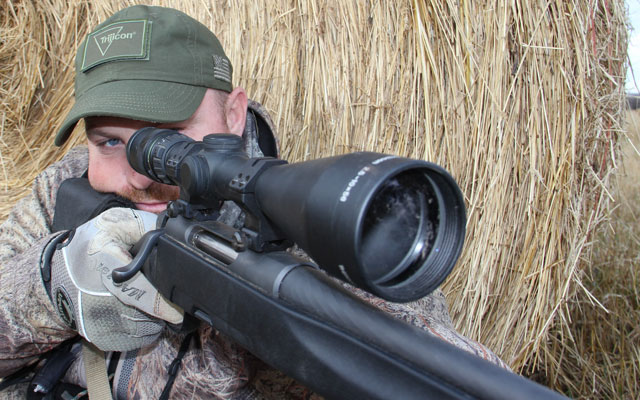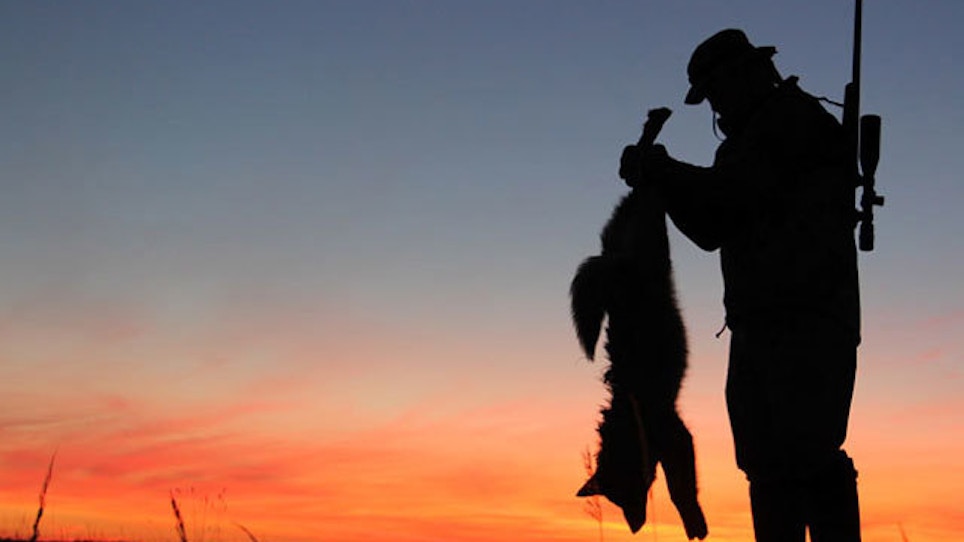In a perfect world, coyotes, foxes and bobcats would hunt during the daytime and sleep at night. They would sneak into your calls under a high, bright sun and turn broadside at 50 yards, offering a well-lit target that any shooter could hit. The world isn’t perfect, of course, and predators don’t always come running when daylight is abundant. In fact, the best predator hunting often takes place in the fading light of the evening or the first few moments of the morning. Spotting a tan coyote in tan grass in poor light can be next to impossible, though. Finding one in a cheap scope? You might as well pray for a perfect world.
It’s not as much the actual cost of the scope that can make or break a low-light hunt. It’s the features within the scope, although you really do get what you pay for. Costlier scopes include the highest-quality glass, fully multi-coated lenses, the best internal parts, precision machining and an exterior that can take all the abuse a predator hunter can dish out.
Lights On!
Some even have lighted reticles. That’s a vital feature, especially in low-light conditions. Plenty of predators have been killed with unlighted scopes, but try one just once and you’ll be convinced they are a must-have tool if you spend lots of time hunting in the dark. The only downfall to a lighted scope is that the battery can die in mid-hunt. That’s not a big deal if you carry a spare, but it can cost you a critter if the battery fails as a coyote slips in at the wrong moment.
“The other issue with some battery-powered aim-points is that the intensity of the light is not adjustable. The better ones are, but those that aren’t can actually be too bright,” says Trijicon media relations representative Eddie Stevenson. “You can have a hard time finding a coyote if the dot or dots are too bright.”
An intense light can also cause vision issues as your eye adjusts to the brightness.
Trijicon solves all those problems by using tritium, a hydrogen isotope that elicits constant light, on its hunting scope aim points. It’s faint enough and small enough that it won’t affect your vision or sight picture, but bright enough to show up under any low-light situation. Even better, there is no on-off switch, no batteries and no other steps necessary to activate the light. It’s always on.
“You don’t see it much in the daytime, but it really stands out under low-light conditions,” adds Stevenson.
You won’t see the crosshairs of any scope very well, either, which is why a lighted aim point is critical when it’s dark. That’s why Stevenson doesn’t think the reticle style makes much of a difference when it’s dark, so he recommends choosing a style you prefer for daylight hunting. They all work just fine, so go with what you like best.
Go Big
 Give extra consideration to the size of your scope’s objective, though. It’s one of the most important features of any scope. Generally, the larger the “bell” the more light the scope allows in. A smaller objective, 32 millimeter, for instance, is a poor choice for low-light conditions. A 40-millimeter is better, but if you live by the light of the moon or even the final minutes of twilight, go bigger.
Give extra consideration to the size of your scope’s objective, though. It’s one of the most important features of any scope. Generally, the larger the “bell” the more light the scope allows in. A smaller objective, 32 millimeter, for instance, is a poor choice for low-light conditions. A 40-millimeter is better, but if you live by the light of the moon or even the final minutes of twilight, go bigger.
A larger objective, say, anything over 50 mm, does come with one minor consideration: It may require high scope rings. The wide bell on the end of the scope might actually rest on the barrel with standard rings, preventing the scope from aligning with the bullet’s flight path. In other words, if the scope rests on the barrel, you likely won’t be able to sight in the rifle.
Higher scope rings will fix that, but that brings up another issue: Your sight picture. Raising the scope even just a little will force you to raise your head to see through the scope. That can affect accuracy. The best shooting form involves keeping your cheek tight to the stock. You can add an after-market cheek pad to keep that check-to-stock weld.
The diameter of the tube also plays a role in a scope’s light-gathering ability. The standard scope tube diameter is 1 inch, but some manufacturers offer 30 millimeter and even 33mm scope tubes.
“Look through both and you’ll notice a pretty big difference,” adds Stevenson. “My favorite predator scope is a Trijicon AccuPoint 2.5-10x56, which has a 30 millimeter tube. It’s a bit heavier than a standard 3-9 scope, but it’s a worthwhile trade-off, especially if you do a lot of night or late-evening and early-morning hunting.”
The range of magnification also plays a role in light transmission. Lower settings, 2.5 or 3-power, for instance, “gather” more light than higher settings. That’s why a high-magnification scope isn’t always a benefit at dusk or dawn. A larger objective can work in your favor if you need to dial your scope’s magnification up, but low-light shot opportunities tend to be fairly.
“I like a scope with a wider range of magnification because it is more versatile,” says Stevenson. “The odds are, you aren’t just using your scope for hunting coyotes in the evening. You may use it to shoot prairie dogs or woodchucks in the middle of the day, or you may even hunt coyotes in the middle of the day. I’d rather have too much scope than not enough, as long as it has the features I need for low-light situations.”
It may not be a perfect world, but a high-quality scope a few vital features can make it as close to perfect as you could expect.






